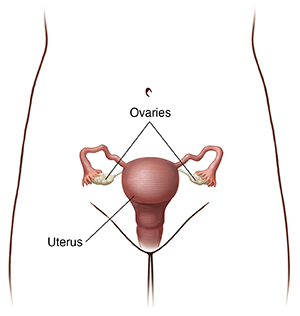Understanding Ovarian Cysts
An ovarian cyst is a fluid-filled sac that forms on or inside of an ovary. The ovaries are a pair of small, oval-shaped organs in the lower part of the belly (abdomen). About once a month, one of the ovaries releases an egg. The ovaries also make the hormones estrogen and progesterone. These hormones are part of pregnancy, the menstrual cycle, and breast growth.
Ovarian cysts are very common in females of all ages. Children can also get them, but this is less common. There are different types of ovarian cysts. They can occur for various reasons, and they may need different treatments. A cyst can vary in size from ½ inch to more than 4 inches (about 10 centimeters).

Types of ovarian cysts
There are different types of ovarian cysts:
Functional cyst
This is the most common type of ovarian cyst. They only occur in a person who hasn't gone through menopause. There are two types of functional cysts:
-
Follicular cyst. This cyst happens when an egg isn’t released and it keeps growing inside the ovary.
-
Corpus luteum cyst. This type of cyst occurs when the sac around the egg doesn’t dissolve after the egg is released.
Endometrioma
This is a cyst filled with old blood and tissue that resembles the lining of the uterus. They are often called chocolate cysts because of their dark color. They can happen in people with endometriosis.
Dermoid cyst
This cyst develops from ovarian cells and eggs. They may have hair, skin, teeth, or fat in them. These cysts are common in people of childbearing age.
What causes ovarian cysts?
Cysts can also be caused by:
-
Polycystic ovary syndrome (PCOS), a condition that causes multiple follicular cysts on the ovaries
-
Pregnancy
-
Severe pelvic infection, such as chlamydia
-
Noncancerous growths
-
Cancer (rare)
-
Fertility medicine to cause ovulation, such as clomiphene
Symptoms of an ovarian cyst
Many people don’t have any symptoms from the cyst. In those with symptoms, the most common is pain or pressure in your lower belly on the side of the cyst. This pain may be dull or sharp, and it may come and go. A cyst that breaks open (ruptures) or twists (torsion) may lead to sudden, sharp pain.
Other symptoms of an ovarian cyst can include:
-
Pain in the lower back or thighs
-
Trouble emptying your bladder fully
-
Pain during sex
-
Weight gain
-
Pain during your period
-
Breast tenderness
-
Abnormal vaginal bleeding (rare)
Diagnosing an ovarian cyst
Your primary healthcare provider, an obstetrics/gynecology (ob-gyn) provider, nurse practitioner, or midwife may diagnose the condition. Your healthcare provider will ask about your health history and your symptoms. You will also have a physical exam. This will likely include a pelvic exam. During the pelvic exam, your healthcare provider may feel the swelling on your ovary. In someone with no symptoms, this is often the first sign of a cyst.
If your healthcare provider thinks you may have an ovarian cyst, you may need tests. These can help your healthcare provider learn the type of cyst. Tests can also help rule out other problems, such as an ectopic pregnancy. The tests may include:
-
Ultrasound. This test uses sound waves to view the size, shape, and location of the cyst. The test can also show if the growth is solid or filled with fluid.
-
MRI. This uses large magnets and a computer to create a detailed picture of the area.
-
Pregnancy test. This is done to check if pregnancy may be the cause of the cyst.
-
Blood tests. These check for hormone problems and may indicate an increase in cancer risk or an infection.